Published in Dance Magazine
Come back stronger by using your body’s natural healing response.
It’s the end of a tiring rehearsal, but you try that challenging jump one last time, and land sideways on your foot. Within minutes you begin to notice the signs of a sprain: swelling, pain and heat, and eventually bruising.
As a group, these symptoms are called inflammation. It hurts—and it looks awful—but is it dangerous? “Inflammation is part of the healing process,” says Dr. Joey Fernandez, a sports medicine specialist with the Harkness Center for Dance Injuries at New York University’s Langone Medical Center. Inflammation is natural and unavoidable, and you can work with it to get back on your feet more quickly.
What’s Happening?
When you have an acute soft-tissue injury like an ankle sprain, Fernandez explains, inflammation sends in immune cells and chemicals, such as neutrophils, cytokines and macrophages, to clear out damaged tissue. “It’s like renovation,” he says. “You put up scaffolding, and the workers have to remove the damage before they can rebuild.”
Get the Swelling Down
Swelling is a result of fluid leaking out of the blood vessels into the surrounding tissue during the inflammation process. This delivers the repair cells to the site, but it can also slow recovery. “Let’s say you have a partially torn ligament,” explains Dr. Selina Shah, who treats dancers at Saint Francis Memorial Hospital’s Center for Sports Medicine in Walnut Creek, California. “The fibers are going to have a hard time coming back together if the fluid from swelling is in the way.”
Immediately after the injury, you can help clear out the excess fluid by wrapping the site in an ACE bandage or brace to apply gentle compression and by elevating the injured area (above the heart, if possible). Ice can also be applied (using a towel to protect your skin from frost burn) for 15 minutes about three times a day. You can continue these treatments for as long as the swelling is visible and you notice a benefit. …

